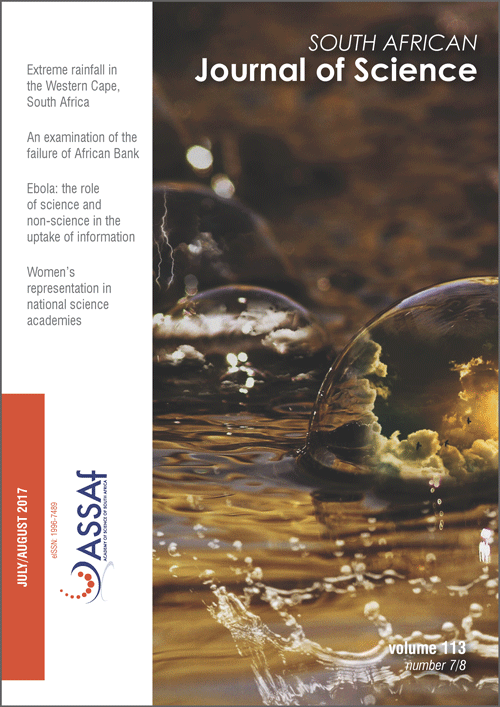Population irruption of the clam Meretrix morphina in Lake St Lucia, South Africa
DOI:
https://doi.org/10.17159/sajs.2017/20160397Keywords:
bivalve molluscs, poleward spread, estuaries, climate, salinityAbstract
The thick-shelled clam Meretrix morphina, previously referred to as Meretrix meretrix, now occurs in the west Indian Ocean region, along the eastern seaboard of Africa, from the Red Sea to the Mlalazi Estuary, close to the Tugela River. Its presence in South Africa is only of recent recording. Meretrix morphina was detected for the first time in Lake St Lucia in 2000. The population declined and was not detected from 2005 until 2011, most likely as a result of a severe drought that resulted in widespread desiccation and hypersalinity in the lake. The system then experienced increased freshwater input resulting in lower salinities from 2011 until 2014, during which time M. morphina reappeared and their population gradually increased. In 2015, M. morphina became abundant in St Lucia, attaining unprecedented densities of 447 ind./m2. Biomass, expressed as a fresh weight, varied in the different basins of St Lucia, ranging from 195 g/m2 at Lister’s Point to 1909.8 g/m2 at Catalina Bay. However, in 2016, when drought conditions returned, M. morphina disappeared. This species appears to thrive under brackish salinities and high temperatures. It is able to establish large populations with high biomass and can become dominant. However, M. morphina is sensitive to desiccation and hypersaline conditions. This clam has substantial commercial value and is exploited along the African east coast, particularly in Mozambique. In future, it may feature more prominently in South African estuaries. However, the ecology of M. morphina is still largely unknown.
Significance:- First record of population irruption of M. morphina in South Africa.
- Report on the largely unknown ecology of a commercially valuable bivalve.
- Update on the taxonomy and poleward spread of M. morphina.
Published
Issue
Section
License

All articles are published under a Creative Commons Attribution 4.0 International Licence
Copyright is retained by the authors. Readers are welcome to reproduce, share and adapt the content without permission provided the source is attributed.
Disclaimer: The publisher and editors accept no responsibility for statements made by the authors
How to Cite
- Abstract 497
- PDF 520
- EPUB 218
- XML 268












.png)